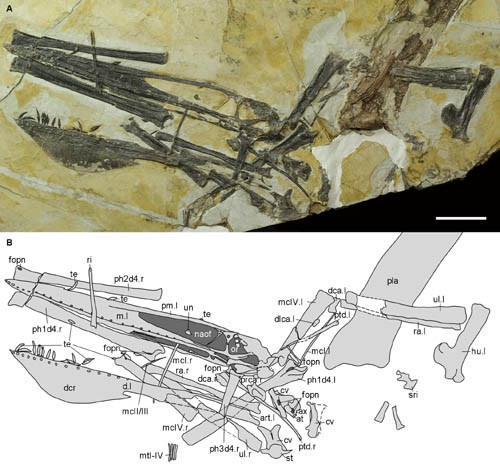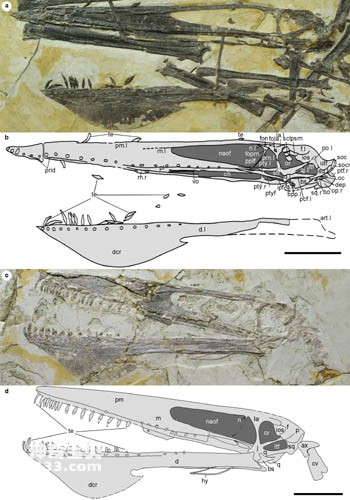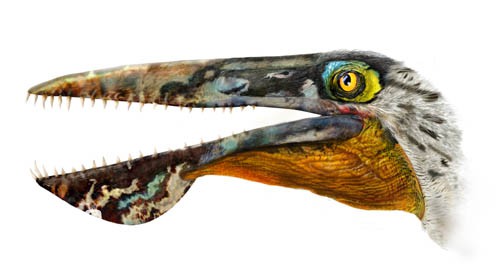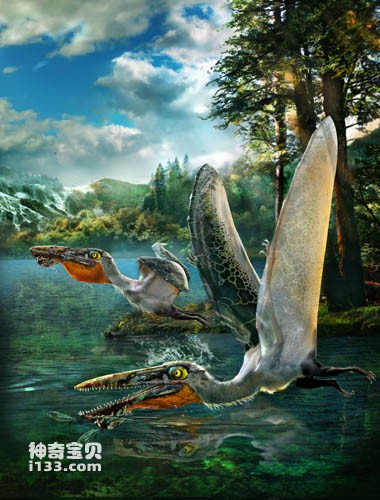The ancient spine is located in a new type of pterosaur found in the famous Jehol Biota in the western Liaoning region of my country about 120 million years ago - Ikrandraco avatar gen.et sp.nov. The top of the skull of this new pterosaur is straight, and a strange blade-shaped semicircular bony ridge and sharp teeth develop on the ventral side of the lower jaw. These are similar to those in the 2009 science fiction movie "Avatar" that became popular around the world. The head of Ikran, the flying winged beast of Pandora, is very similar, hence its name. However, the newly discovered pterosaurs this time are much smaller than the Icaran in the movie. Their wingspan is only about 1.5 meters, while Icaran's wingspan can reach 12 meters, which is equivalent to the largest known pterosaur on earth. In "Avatar 1", there is also a larger type of flying animal - Leonopteryxy, which the alien Na'vi people call Toruk. They are larger in size and have a wingspan of up to 25 meters.

Figure 1 The holotype specimen of Avatar Ikaran Pterosaur (IVPP V18199)
Although the creatures on the fictional planet Pandora are completely different from the creatures on earth, we can always find the shadow of earth creatures in those strange alien creatures. The most impressive thing in this movie is the flying winged beasts-Ikaran and Phantom. These flying animals do not look like birds or bats. They are obviously not imagined by the filmmakers. These large flying animals that are used as mounts by the Na'vi people to fly in the air are largely based on references that are now extinct. The extinct flying reptile-Pterosaur can be said to be a mixture of pterosaurs and flying vertebrates such as birds. The most unforgettable thing in the film is the protagonist's mount Phantom, whose head shape is a collection of two pterosaur skulls. The Phantom has headdresses on its upper and lower jaws, and its mouth is full of sharp teeth. This is similar to the Ancient Demon Pterosaur, except that the Ancient Demon Pterosaur's headdress is arc-shaped, while the Phantom's is sail-shaped. We can see such a headdress in The Ancient God Pterosaur was found on its head, but this pterosaur had no teeth. The much-anticipated Phantom is actually a combination of these two pterosaurs. Both the Ancient Demon Pterosaur and the Ancient God Pterosaur have been found in China and Brazil, while the Ancient God Pterosaur is currently only found in China and Brazil. Their survival times are roughly the same, dating back to the mid-Cretaceous period about 110-120 million years ago. . Eklan was apparently slightly modified from the Phantom by the film's artists, removing the headgear at the top of his skull and retaining only the ridged structure of his lower jaw. Surprisingly, this artist's imagination has provided us with an advance depiction of a flying earth creature that lived in the Cretaceous Period. This is the latest pterosaur discovery—Avatar Ikaran Pterosaur.

Figure 2 Comparison of the skulls of the holotype (IVPP V18199) and the classified specimen (IVPP V18046) of Avatar Ikaran Pterosaur
The new pterosaurs include two fossil specimens from the Jiufotang Formation of the Lower Cretaceous in western Liaoning. The holotype specimen was produced in Lama Cave, Jianchang, and preserved a complete skull, mandible, and part of the body skeleton; the other specimen was produced in the adjacent Sihedang, Lingyuan, and contained a complete skull, mandible, and part of the cervical vertebrae. The two specimens were produced about 20-25 kilometers apart, and both occur in the lacustrine shale of the Jiufotang Formation. Among the pterosaur fossils that have been discovered, Ikaran Pterosaur is a rare type in which more than one relatively complete specimen of the same genus and species has been found. Although there are some small differences between the two specimens, such as the second specimen (head length 268.3 mm) is slightly smaller (about 6% smaller) than the holotype (head length 286.5 mm), the two specimens have almost identical characteristics. The ratio of the length of the anterorbital foramen to the skull; although the mandibular ridge of the second specimen is larger than that of the holotype, the lowest point of the mandibular ridge of both specimens is located between the 9th and 10th mandibular teeth. And so far only Icaranopterus is known to have a mandibular ridge but not a maxillary ridge. In addition, a small uncinate process developed at the posterior end of the mandibular ridge in these two specimens. Similar morphological structures have never been found in other pterosaurs. Based on this, it is believed that the two specimens belong to the same genus and species of pterosaur.

Figure 3 Reconstruction of the head of Avatar Ikaran Pterosaur
Cladistics research shows that Icaran Pterosaur belongs to the superfamily Pteranodontoidea and has some inbred characteristics and combinations of characteristics that distinguish it from other pterodactyls: the dorsal side of the skull is slightly above the anterior orbital opening. Arched; lateral depression of the nasal bone; uncinate process on the posterior edge of the mandibular ridge on the ventral side of the mandible; two well-developed spiracles on the side of the axis; low skull (height is 18.7% of the length); strong retroclination of the quadrate bones (150) ; The premaxilla is straight and ridgeless; the mandibular bony ridge is blade-shaped, with the highest point in the middle; there are spiracles on the ventral sides of the proximal ends of the second and third wing phalanxes. The second Icaran pterosaur was produced at the Sihedang site in Lingyuan. Wang Xiaolin and others also discovered a strange pterosaur with huge teeth on the snout and a ridge on the back of the head - the Hunter Ghost Dragon. In addition, they also discovered in western Liaoning Other fossil sites of the Jiufotang Formation have found Nurhachipteryx and Liaoning Pterosaur. These medium to large fish-eating pterosaurs are closely related to the Ikaran pterosaur discovered this time, but their classification positions are more precise. Still awaits further research.

Figure 4 Ecological restoration map of Avatar Ikaran Pterosaur
Based on the morphological and phylogenetic analysis of these two pterosaur fossils, paleontologists from China and Brazil conducted an in-depth discussion on the morphology, function and hunting methods of Icaranopterus. The biggest difference between Icaranopterus and other known pterosaurs is that it only developed mandibular ridges and no maxillary ridges. This peculiar headdress form has never been found in known pterosaurs, and there are no examples in living animals, so the function of the mandibular ridge cannot be accurately known. Scientists have explained the various functions that the skull ridge may have. They believe that the most common function of the skull development ridge (headgear) is display, whether it is gender display or interspecies display. It is obvious that it is much higher on the head than on the head. The lower part of the head is easier to find and has a more display effect, and is more likely to attract the attention of other individuals or the opposite sex. Therefore, the Icaran pterosaur with only a mandibular ridge greatly reduces the possibility that the headdress is only used for display function. Judging from the surface of the mandibular ridges of the two specimens, no groove-like blood vessel imprints were found on the skull ridges of Sea Skimmer Pterosaur, so the possibility of their function as heat dissipation is also small. The rest is about the functions related to dynamics. The mandibular ridge of Icaran Pterosaur is semi-circular, with a smooth blade-like edge. It probably also has a thin layer of horny sheath, which makes it easy to fly and fly. It has the function of cutting fluids and reducing resistance when hunting. It is speculated that when the Icaran pterosaurs hunted food in the freshwater lakes where they lived, they would fly close to the water surface, and the thin mandibular ridges cut part or all of the water into the water. Once the water surface was found, Nearby prey is quickly captured, and the mandibular ridge plays a role in cutting the water flow and targeting prey during this hunting process, which is very similar to the hunting behavior of living shearwaters. Some researchers once believed that the pterosaurs that were previously speculated to fly low on the water for prey may not have this ability. The reason is that they are too large and consume much more energy to fly and hunt so close to the water. The wingspan of Icaran Pterosaur is only about 1.5 meters, which makes it a small and medium-sized pterosaur. It is only slightly larger than the Scissor Gull (wingspan is about 1.2 meters), so Icaran Pterosaur is not just used occasionally. This way of hunting.
There is an obvious uncinate process developed on the back of the mandibular ridge of Icaran Pterosaur. This feature has not been found in other pterosaurs and living animals. Although some pterosaur fossils are inferred from their skin impressions that they have throat pouches similar to those of living pelicans, there is no conclusive evidence. However, the uncinate process developed by Icaranopterus is probably the best evidence that it has a throat pouch. The main function of this structure is to attach the soft cortical throat pouch, and it also represents the most anterior position of the throat pouch. The function of the throat pouch of Icaranopterus may be slightly different from that of pelicans. Pelicans use the throat pouch to hunt for food, while Icaranopterus probably uses the throat pouch to store fish caught continuously and nearby on the surface of the water. There is no need to swallow food immediately after each capture, nor does it need to fly out of the water to find the target for the next prey. This kind of hunting behavior plays a very good role in saving physical energy, and also represents a new way of pterosaur hunting.
animal tags:
We created this article in conjunction with AI technology, then made sure it was fact-checked and edited by a Animals Top editor.